Our Roots Are Still Alive - Chapter 15
Previous: Chapter 14
Table of Contents
Next: Chapter 16
New Jersey Solidarity-Activists for the Liberation of Palestine Main Site
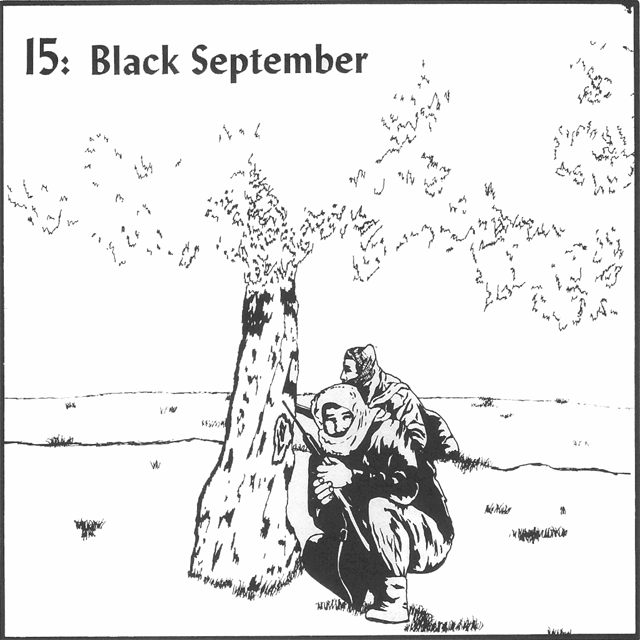
- Now all day long the loudspeakers are asking the refugee camps to surrender .... How can a refugee camp surrender and to whom? Is there a surrender greater than the life of the camps?
- Diary of a Resistance Fighter, September, 1970
The United States Assistant Secretary of State, Joseph Sisco, took off from Washington on a "peace mission" to the Middle East in April 1970. In Amman, Jordan, tens of thousands of demonstrators, mostly Palestinians, marched through the streets to protest Sisco's visit. They burned down the U.S. Information Agency and damaged the U.S. Embassy. The Palestinians knew that an American "peace" meant a drive for more U.S. control at their expense. Sisco canceled his stop in Jordan. But he and other U.S. diplomats would soon return. They had watched the steady growth of the Palestinian Resistance and of Soviet influence in the whole region since 1967. Now they intended to stop both.
Significant Soviet influence in the Middle East had begun when the Soviet Union supplied aid to Nasser to build the Aswan Dam in 1956. Since then the Soviets had been trying to develop strong ties with regimes who were taking the "non-capitalist road" of development. The Soviet Union had signed trade and technical assistance agreements with Egypt and Syria in the late 1950s, and had armed them during the 1960s. It had supported the People's Democratic Republic of Yemen when it formed in 1967. After the June War, it helped rebuild the shattered armies and air forces of Syria and Egypt. It helped Iraq explore for and market oil after the radical Iraqi government nationalized U.S. oil companies. The number of Soviet advisers in the area and the size of the Soviet fleet in the Mediterranean grew rapidly after 1967.
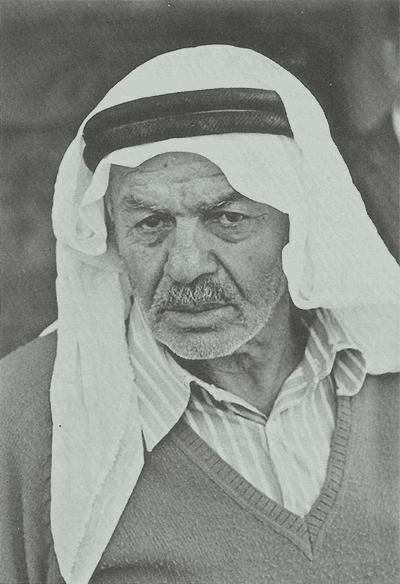
The Soviet Union wanted to erode U.S. economic and military strength in the area. Soviet leaders believed that American forces and allies so near Soviet borders posed a grave threat to Soviet security. The Soviets wanted the Americans to leave and encouraged allies of the United States to adopt a neutral or pro-Soviet foreign policy. This led the Soviet Union to support, with some caution, nationalist governments and movements which confronted U.S. imperialism militarily and economically - as long as these confrontations did not seriously disrupt the stability of the area or bring the Soviets into direct conflict with the United States.
In the view of U.S. policy-makers in 1970, the Soviet Union's support of Egypt's "war of attrition" against Israel might well lead to a U.S.-Soviet confrontation. Egypt began the limited war in 1969, by shelling Israeli positions along the Suez Canal. The war escalated rapidly after the United States delivered fifty sophisticated Phantom jets to Israel. Israeli pilots flew these jets deep into Egypt and struck civilian targets. In April of 1970, as Sisco proclaimed the "peaceful" intentions of the United States, a Phantom jet dropped bombs on an Egyptian school, killing forty-six children. Nasser requested and got anti-aircraft missiles from the Soviet Union to counter the Phantoms.
The Rogers Plan
To prevent a further escalation, U.S. officials tried to put into effect a plan that they had been working on since 1969. It proposed a general settlement for the Arab-Israeli conflict. The Rogers Plan (as it was called, after Secretary of State William Rogers) was based on UN Resolution 242. It offered Arab leaders the return of some of their territory lost in the June War, in exchange for their recognition of Israel and the establishment of secure borders. The Rogers Plan, like the UN resolution, denied the rights of Palestinians to their homeland. It treated them simply as a "refugee problem." Acceptance of the Rogers Plan by Arab governments would undermine the Palestinian movement and remove the Arab states from the fight against Israel.
A main aim of the American plan was to pull Egypt away from the Soviet Union and into the U.S. orbit of influence. Henry Kissinger explained in a background briefing in June 1970:
- We are trying to get a [Middle East] settlement in such a way that the moderate regimes are strengthened, and not the radical regimes. We are trying to expel the Soviet military presence. . . .1
Sisco's April mission to the Middle East was to test the reaction of Arab leaders to the American proposal.
King Hussein was the most responsive. He wanted to endorse the Rogers Plan, but he knew that such a betrayal of the Palestinians could cost him his throne. With each month, more Palestinians in Jordan were drawn to the program of the fedayeen. Already Irbid, Jerash and other cities in northern Jordan were controlled by Palestinian guerrillas. From his palace Hussein could see armed guerrillas patrolling the streets of Amman. Before he could accept the Rogers Plan he had to try once more, as he had tried the previous November, to subdue the fedayeen. On June 6 his Bedouin troops attacked the Palestinian guerrilla base at Zerka and shelled the nearby refugee camps. Once again the resistance of the popular militias and the guerrilla movement forced Hussein to back down and withdraw his troops.
When Hussein failed to defeat the Palestinians in Jordan, the United States stepped up its drive to persuade Nasser to accept the Rogers Plan. If Nasser - the historic "friend" of the Palestinians - accepted the plan, then Hussein could do so more easily. By the summer of 1970 the "war of attrition" between Egypt and Israel had gone far beyond the limited war Nasser's army was capable of waging. Already the Egyptian people were pressing for a settlement that returned Egypt's land or total mobilization against Israel. The United States offered him a way out of the dilemma with the Rogers Plan. Nasser endorsed it on July 24, 1970. A few days later Israel accepted the plan, realizing that it would end the "war of attrition" with Egypt and allow Hussein to attack the Palestinians in Jordan.
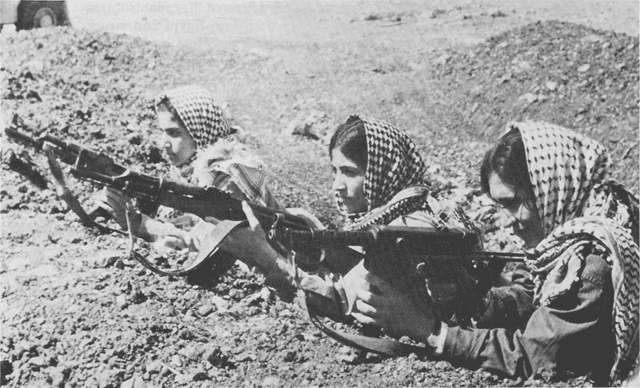 Women fighters in Jordan, September, 1970.
Women fighters in Jordan, September, 1970.
Many Palestinians were stunned. Despite Nasser's many past achievements, this act was too familiar. It reminded Palestinians of the self-serving betrayals of the Arab kings in 1936 and 1948. Nasser tried to muzzle Palestinian criticism by closing down the Cairo radio station that broadcast the "Voice of Palestine" and by expelling several hundred Palestinian students from Cairo University. In Amman, ten thousand people silently marched against the Rogers Plan. In the West Bank, demonstrators' placards branded Nasser a "traitor."
In Amman, Jordan, heavy tanks, artillery and napalm began arriving daily, directly from the United States. Jordanian troops patrolled the border to capture Palestinian guerrillas returning from the West Bank. Palestinian organizations felt themselves trapped inside a circle that grew smaller every day. They were not ready to fight Hussein. Although they had developed ties with many people in Jordan, their base of support was not well-organized. Two years of rapid growth had its shortcomings. Many guerrillas were inexperienced and poorly armed. Yet, Palestinian leaders knew the attack would come soon.
Fatah stepped up its pressure on Nasser to come to the aid of the Palestinians. Both the Popular Front and the Democratic Front thought negotiating with Nasser was a dead end. In August the Democratic Front called for setting up a democratic government in Jordan to replace Hussein. But the call came only days before the crisis broke. On August 29, 1970, Hussein officially accepted the Rogers Plan.
Hussein's army had been steadily attacking Palestinian bases in southern Jordan during the previous two weeks. On August 30, 1970, members of the Popular Front boarded jumbo jets of Swissair, TWA and BOAC and commanded the pilots to fly to Jordan. They hoped to pressure Hussein to end his attacks on the camps and guerrillas in Jordan. When Hussein ignored their demands, they removed the hostages and blew up the jets. On September 13, Hussein ordered all Resistance fighters to turn in their arms. The Resistance responded by issuing a call for a general strike to demand the participation of Palestinians in the government. All guerrilla organizations met in Amman and hastily set up a unified command.
Hussein Attacks
In the pale dawn of September 15, the storm broke over the city. At 5:00 A.M. Jordanian tanks and armored cars began shelling any suspected guerrilla positions in the refugee camps. The army imposed a curfew on Amman, shooting on sight anyone caught on the streets. The guerrillas quickly prepared to fight. In a battlefield diary, a young guerrilla, code-named "Bassem", recorded Hussein's first attack on the Resistance offices, all in the same section of Amman:2
- Suddenly we all got together. All the barriers between organizations disappeared. We met together in a trench, behind a wall, on the sites of the ruins of offices. All of us from different groups were working together without hesitation.
They fought for four hours, holding their own. Bassem recorded:
- Then something unexpected happened. The cannons of the tanks shelled the houses in a totally unnecessary way. Savagely, without even differentiating between homes and commando offices. It was really frightening. We were paralyzed, seeing the houses collapsing and suddenly seeing in the unexpected rubble many of the small private things of people, the warm small things of people, torn, sometimes bloody.
As the tanks rolled down the streets, some fighters began to retreat. But then:
- Abu Ammar [Yasser Arafat] came down to Hussein Street. He asked the fighters who were retreating to stop running away and to plant mines and build barricades of cars, gas cans, any kind of metal. He brought his own car himself, and with some other men, pushed it into the middle of the street. Immediately high morale filled the area and men started to come back.
Leaders of the other guerrilla groups joined the fighters in the streets as the battle intensified. The Palestinians fought stubbornly with light weapons against Hussein's heavy artillery. In the camps around Amman the situation was desperate. Napalm rained from the skies and fires raged uncontrollably through the crowded camps. The desperate fighters hoped for some word of support from other Arab countries. None came. When radio reports confirmed the official silence of the Arab governments, Bassem said it was "as if a hand had caught [our] necks in the darkness." Only Syria sent a tank column across the border, but it was driven back. Bassem's last entry from the embattled Hussein camp read:
- I am afraid that here at least everything is coming to an end. I can see only that people prefer to die resisting. Death is in every square inch of the Hussein refugee camp. Also thirst and hunger .... Now our men fight starvation in the first line as they face the tanks.
After eleven days of fighting the guerrillas still held most of their military positions in the north of Jordan and in the camps. But five thousand people had been killed and twenty thousand wounded - most of them civilians. Food and supplies were running low. On September 25, the Central Committee of the Resistance sent Yasser Arafat to Cairo to negotiate a cease-fire.
As people ventured into the streets of Amman, they found among the bodies and ruins of buildings thousands of ammunition cartons stamped "Made in the U.S.A." The markings revealed the hand behind the Black September attack. At a top-level meeting in Washington during the heaviest fighting in Jordan, the Israeli and Jordanian ambassadors had met with Henry Kissinger and the heads of the Defense Department, the CIA and the Joint Chiefs of Staff. They planned an Israeli attack on the Palestinians, code-named "Operation Brass Strike," in case Hussein's army failed to do the job or Syria intervened. In the Mediterranean the U.S. Sixth Fleet steamed towards the coast nearest Jordan and U.S. troops boarded giant cargo planes at U.S. bases in Turkey.3 After the cease-fire, U.S. planes rushed more supplies and weapons to Hussein. The U.S. government gave Hussein $35 million in emergency aid over the next three months.
While the United States was rearming Hussein, the Palestinian guerrilla organizations were meeting in the mountains of Jordan to probe the lessons of Black September. Ghassan Kanafani of the Popular Front wrote:
- Shocks like September crystallize the strength of the revolution, because they have forced it into the mountains. There are now commandos living ... in caves, with limited water and food and little ammunition. In this situation, we can't expect that the thousands who went around Amman in khakis carrying their Klashnikovs will lead this kind of life.4
Both the Popular Front and the Democratic Front firmly believed that Black September was the "heavy price" the Resistance paid for trusting in the Arab regimes. They argued that it was not just Hussein, but all the Arab leaders who had remained silent, who bore responsibility for the thousands killed and wounded. The Palestinians' only lasting allies would be the progressive forces in the Arab countries.
Fatah, by far the largest of all the organizations and the one with the broadest range of views among its members, was torn with internal disagreement over this question. Everyone agreed that Hussein's actions had branded him an enemy of the revolution, and that the other Arab leaders had failed to act. A few Fatah leaders agreed with the Popular and Democratic Fronts. Some thought the Resistance could rely on Egypt and Syria for support in the next lean years. Others did not think Egypt and Syria could be relied on, but argued that the Resistance could not alienate them and lose its freedom of movement in those countries.
All groups agreed that the Resistance in its two short years in Jordan had failed to fully mobilize the people behind a program to support the Palestinians and democratize Jordan. At the March 1971 Palestine National Council meeting, one hundred ten Jordanian nationals joined the Palestinian delegates. The Council resolved that the Jordanian and Palestinian people had to unite closely to fight against Hussein. Despite unresolved struggles over strategy, the Council overwhelmingly affirmed for the first time that the goal of the revolution was a democratic secular state in all of Palestine.
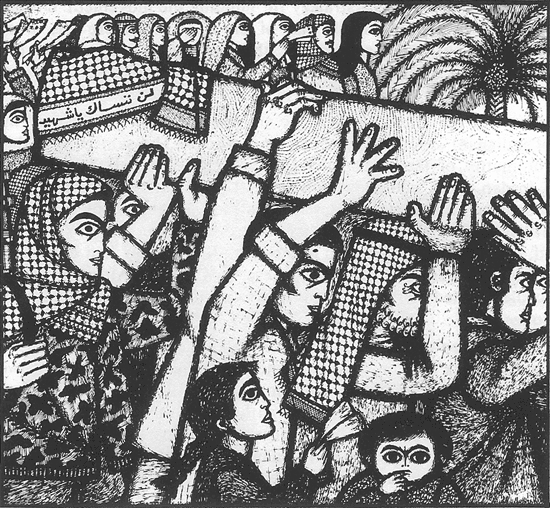
As the Palestine National Council was finishing its session, Hussein intensified his drive to get every guerrilla off of Jordanian land. He pressed the attack throughout 1971. In July he ordered his Prime Minister, Wasfi Tal, to move against the last strongholds of the guerrillas. The Jordanian army moved into the forests of Ajloun, the base for eighteen hundred guerrillas. After four days of fierce fighting and heavy napalming, the Jordanians had captured or killed all but fifty guerrillas. On the orders of Prime Minister Tal, Jordanian soldiers killed the captured Fatah military leader, Abu Ali Iyad. They dragged his body behind a tank through nearby villages. They wanted to make a clear point to any potential supporters: "The Resistance is dead!"
The Resistance Will Not Die
Four months later Wasfi Tal was standing on the steps of a Cairo hotel when bullets rang out, killing him instantly. The group responsible for his death called itself "Black September" and said that Tal's assassination was in memory of the young fedayeen leader, Abu Ali Iyad. "Black September" went on to answer the latest wave of terror aimed at the Palestinian people with a highly disciplined secret war that focused on Israel and Jordan.
Cut off from the old bases in Jordan and facing stepped-up Israeli border patrols, the Palestinian fighters from all groups tried many paths to develop a political and military strategy that could defeat Zionism and its allies. The raids into Israel and the occupied territories were increasingly difficult and dangerous. Yet there were strong differences within the Palestinian movement about the wisdom of relying on external operations like hijackings as a strategy for building the movement. Groups like "Black September" were not formally part of the PLO, and there was much debate about the effect of their actions on the Palestinian cause. But few Palestinians questioned the absolute right of the Palestinian people to use every available means in their fight for freedom.
In Israel, Europe and the United States, the actions of "Black September" inspired a flood of indignant speeches, editorials and articles. The same media that had applauded or matter of factly reported Hussein's massacre of thousands of Palestinians in Jordan were suddenly outraged at the actions of Palestinian "terrorists." Editors and commentators described armed attacks on illegal Israeli para-military settlements in the occupied territories as "terrorism." When the Israelis retaliated, their attacks were called "reprisals." Just as they had done with the wars in Vietnam, Algeria, or the Portuguese colonies in Africa, Western politicians and media shouted "terrorism" to obscure the justice of people's fight for national liberation.
So it was when "Black September" took eleven Israeli athletes hostage at the 1972 Olympics in Munich. "Black September" commandos demanded the release of two hundred Palestinian political prisoners held in Israeli jails. Israel refused to negotiate. Under Israeli pressure the German authorities moved on the planes carrying the hostages and opened fire. All the guerrillas and hostages died. Western officials and the media heaped abuse on the Palestinians and carefully refrained from criticizing Israel's role in the deaths. In September of 1972 the Israeli Air Force mounted a "reprisal raid" against southern Lebanon in retaliation for the "Black September" action at Munich. The raid killed three hundred people.
The September raid was not the first. In February and June Israeli planes had struck deep into the south of Lebanon for saturation bombing of the area that the Israelis called "Fatahland" - where many Palestinian guerrilla base camps were located. These raids were part of Israel's general offensive against the Palestinians in the wake of Black September. Israeli leaders hoped now to finish off the Resistance once and for all.
The previous year Moshe Dayan had begun to prepare the way for new Jewish settlements in the Gaza Strip. He ordered a massive "security round-up" of Palestinians he believed to be potential trouble-makers. He placed the entire Strip under a curfew and conducted house-to-house searches of some camps. Israeli troops blew up houses to widen the roads for better surveillance. They punished any resistance swiftly and strongly. After a year of operations, they considered Gaza "pacified." Yet in September of 1972, rioting broke out in the Gaza camp of Shatti. Using sticks and homemade weapons, young Palestinians fought hit-and-run battles with the occupation troops. Despite massive arrests, curfews, beatings and shootings, sporadic rioting continued all during the fall.
The Palestinian leaders recognized the importance of this resistance in Gaza and similar unrest in the West Bank. National Council meetings of the PLO in both 1972 and 1973 called for the formation of a national front in the occupied territories to connect the struggle there with that of the Palestinians in exile. Contacts between groups in the West Bank and Gaza took place in the beginning of 1973. Meeting in greatest secrecy, trade unions, women's and students' organizations, and political parties, including Jordanian communists, hammered out the organization of the Palestine National Front (PNF). The announcement of its formation on August 15, 1973 spread like wildfire throughout the occupied territories. The PNF became part of the PLO, but its function was to represent directly the people under Israeli occupation.
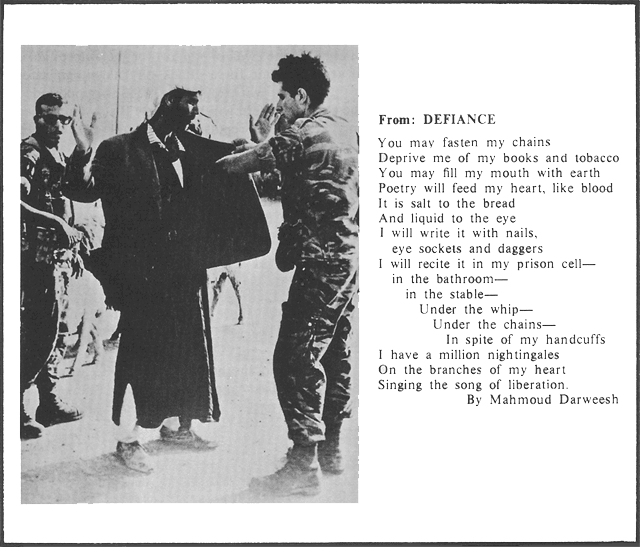
Members of the Front built cell organizations, distributed literature, tried to resolve people's grievances and organized strikes and boycotts. One of the Front's first activities was to organize a boycott of the September 1973 trade union elections held in Jerusalem by Israeli authorities. The Israelis thought that the participation of Palestinian Arabs in the elections would symbolize their acceptance of Israeli annexation of Jerusalem. Largely through the Front's efforts, only about 6 percent of the Palestinian Arab workers voted. The boycott was a success. Such mass demonstrations of support made it increasingly clear that only the PLO could claim to speak for the Palestinians.
In Lebanon, too, the Palestinian Resistance was recovering from the effects of the setback in Jordan. On April 10, 1973, an Israeli commando group moved silently into Beirut. They murdered four top Palestinian leaders, including Kamal Nassar, one of Palestine's foremost poets. One-fifth of Beirut -a quarter of a million people marched in the funeral procession of the fallen leaders. Lebanese poor and working people shut down the city in a general strike to protest the government's passivity. Government leaders were frightened by the swell of support for the Palestinians. In May they ordered a full-scale army and air force attack on Palestinian refugee camps around Beirut. Again, Lebanese workers and students supported the Palestinians, this time under the slogan, "There will be no new Black September in Lebanon." The Lebanese Army attack was repulsed in several days of heavy fighting.
Despite the setback in Jordan, the repression in the West Bank and Gaza and the Israeli bombing of Lebanon, the Palestinians were able to build new organizations and new alliances. The much-heralded "death" of the Palestinian movement had not occurred. Yasser Arafat, speaking of the Gaza uprisings in 1972, praised this Palestinian resilience:
- Moshe Dayan said, "I have finished off the resistance in Gaza." But today we see the resistance in Gaza breaking out again, although he made the streets 120 meters wide in our camps and though he has deported a third of our people from the Strip. In spite of this, resistance has broken out again - this generous sacrifice! How do trees die? They die standing up so that new trees and flowers may spring up.5
The Palestinian people continued to stand in the way of all who would make "peace" in the Middle East at their expense. Among these was the new leader of Egypt, who was trying hard to reach a settlement with Israel.
Footnotes
- Briefing at San Clemente, California, 26 June 1970, cited by Eqbal Ahmed, "A World Restored Revisited: American Diplomacy in the Middle East," Race and Class, vol. 17, no. 3 (Winter 1976),p. 223.
- Russell Stetler, ed., Palestine: The Arab-Israeli Conflict (San Francisco: 1972), pp. 246-57.
- Sheila Ryan and Joe Stork, "U.S. and Jordan: Thrice-Rescued Throne," MERIP no. 7, p. 5.
- Stetler, p. 275.
- Interview with Yasser Arafat in Filastin al-Thawra, 1 January 1973, reprinted in Journal of Palestine Studies, vol. 2, no. 3 (Spring 1973), p. 169.